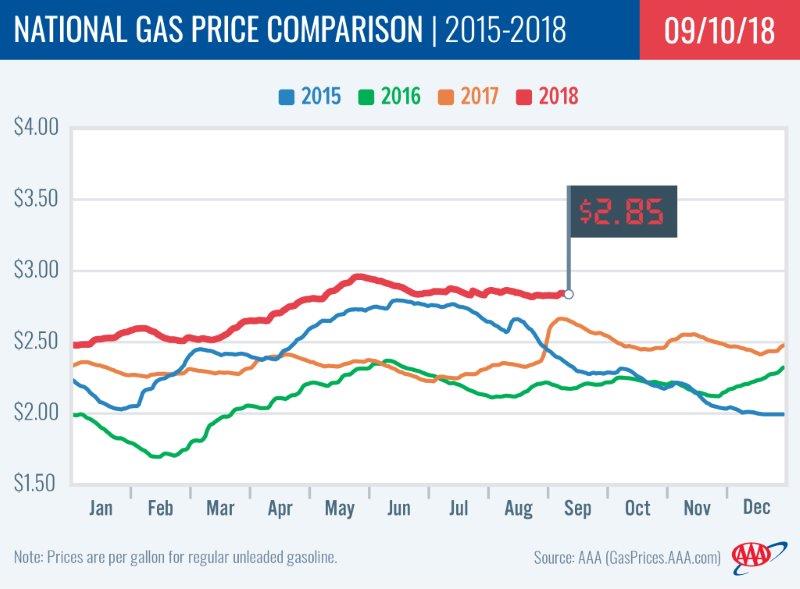PORTLAND, Ore., – Retail gas prices are fairly flat as demand for gasoline dipped slightly and gas inventories showed small gains. For the week, the national average for regular adds a penny to $2.84 while Oregon’s average remains at $3.26.

Hurricane Florence could cause pump prices to spike on the East Coast this week, especially in South Carolina, North Carolina and Virginia. The storm is a Category 4 and could strengthen to become a Category 5 hurricane before making landfall as projected late Thursday or early Friday. There are no refineries in Florence’s path so U.S. crude processing will not be impacted. Fuel deliveries in the impacted areas are likely to be reduced, due to road closures and power outages, limiting fuel supply at terminals and at local stations.
“A storm like this typically causes an increase in fuel purchases in the impacted markets before the storm followed by a slowdown in retail demand. Any spikes in pump prices will be brief but dramatic. Since Sunday, the average price for unleaded gas along the path of the storm has remained relatively stable,” says Marie Dodds, public affairs director for AAA Oregon/Idaho.
AAA urges travelers to check with their travel agent and travel providers for cancelation policies and itinerary changes. Travelers should follow all official evacuation advisories and orders. Many airlines are waiving change fees and issuing changes to rebooking policies as a result of the storm. Check with your airline on their policy, check your flight status before leaving for the airport, and sign up for text or mobile alerts from your airline for the latest flight information.
If you have hotel reservations, check with your hotel for local updates on the storm’s impact. Several cruise lines have altered itineraries in advance of the storm so travelers should check with their cruise line or travel agent for updates.
In most parts of the country, AAA expects gas prices to decline this month due to the switchover to winter-blend gasoline which occurs September 15. This fuel is less expensive to produce than the more environmentally-friendly summer-blend fuel.
Oregon is one of 17 states where prices have decreased week-over-week. Florida has the largest decrease (-3.5 cents). Delaware has the largest weekly increase (+12 cents). This week 10 states have averages at or above $3 a gallon, same as a week ago.
Oregon is one of 36 states and the District of Columbia where prices are lower than one month ago. The national average is two cents less and the Oregon average is one cent less than a month ago. Oregon has the 36th-largest monthly decrease in the country. Michigan (-11 cents) has the largest monthly decrease, while Colorado (+8 cents) has the largest monthly increase.
The West Coast continues to have the most expensive gas prices in the nation. Hawaii tops the list for the 14th week in a row with California, Washington, Alaska, Oregon and Idaho and Nevada rounding out the top seven. Oregon is fifth for the second week in a row. Prices in the region are mostly flat compared to last week.
According to OPIS (Oil Price Information Service), a handful of West Coast refineries including Andeavor’s Martinez refinery, Chevron’s Richmond refinery and two Phillip’s 66 refineries near San Francisco and Puget Sound may begin refinery maintenance in the coming weeks. The U.S. Energy Information Administration’s (EIA) weekly petroleum status report showed West Coast motor gasoline stocks totaled 28.3 million bbl, which is 2 million more than the 26.3 million bbl seen at the same time last year. This 2 million bbl cushion in gasoline stocks may prevent increases at the pump during refinery turnaround season, barring any unforeseen unplanned outages or prolonged maintenance.
The nation’s cheapest markets are Alabama ($2.52) and Missouri ($2.54). For the 58th week in a row, no states have an average below $2.
Drivers in 47 states and the District of Columbia are paying more than a year ago to fill up. The national average is 20 cents more and the Oregon average is 34 cents more than a year ago. This is the 10th-largest yearly increase in the country. Hawaii (+67 cents) has the greatest year-over-year increase; Utah (+50 cents) is second; California (+47 cents) is third; Idaho (+45 cents) is fourth; and Arizona (+45 cents) is fifth.
Oil Market Dynamics
Crude oil prices are rising today as Hurricane Florence takes aim at the U.S. East Coast. Last week, crude prices were fairly flat with several factors putting upward and downward pressure on prices, including increasing U.S. gasoline inventories, concern regarding U.S. sanctions against Iran, and instability in production in Libya and Venezuela.
According to EIA’s report, total motor gasoline inventories increased by 1.8 million bbl last week and are about 7 percent above the five-year average for this time of year. At the same time crude oil stocks dropped 4.3 million barrels from the previous week as refinery utilization rates reached 96.6 percent.
At the close of Friday’s formal trading session on the NYMEX, WTI dropped two cents to settle at $67.75. At the close of Monday’s formal trading session on the NYMEX, WTI dropped 21 cents to settle at $67.54. Today crude is trading around $69, compared to $70 a week ago. Crude prices are up about three percent in the last month and are about $20 more per barrel than a year ago.
Drivers can find current gas prices along their route with the free AAA Mobile app for iPhone, iPad and Android. The app can also be used to map a route, find discounts, book a hotel and access AAA roadside assistance. Learn more at AAA.com/mobile.

Diesel
For the week, the national average adds a penny to $3.18 a gallon. Oregon’s average remains at $3.39. A year ago the national average for diesel was $2.71 and the Oregon average was $2.92.
Find current fuel prices at GasPrices.AAA.com.
AAA news releases, high resolution images, broadcast-quality video, fact sheets and podcasts are available on the AAA NewsRoom at NewsRoom.AAA.com.

